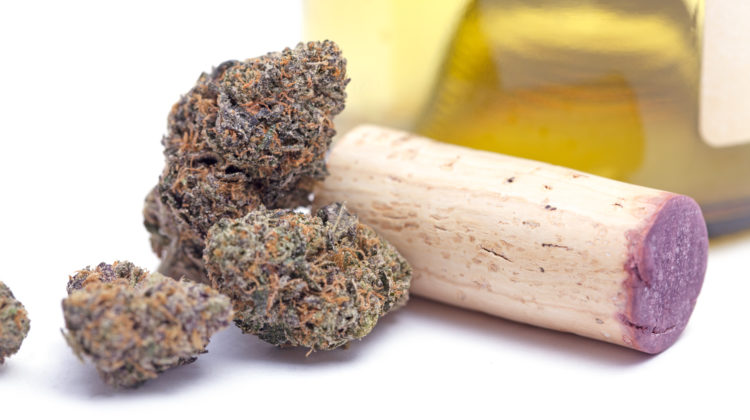
Wine and weed, two star-crossed lovers. Photo credit: Canna Obscura.
As fall approaches, cannabis and grape growers alike prepare for the harvest season. Many consider Northern California the mecca for these crops. However, the two industries may be neighbors, but they haven’t quite worked out their boundaries yet.
Wine and Weed: Same, but Different?
To little surprise, these two crops endure similar challenges in terms of the harvest itself. They mirror each other’s environmental needs and as a result, they withstand the same external factors.
Jared Giammona founded The Sonoma County Experience, a tourist’s dream that takes guests through the heart of the world renowned Napa Valley.
He explains, “you’re harvesting around the same time in September and October. You’re dealing with the same elements: mother nature, insects, mold and lately in California we have the fires,” he continues. “They have similar watering techniques. They can also both be done in-ground, which is a big push for the cannabis community in Northern Cali.”
But no two crops are exactly alike. For example, “cannabis is a whole harvest plant, so in October or September you’re harvesting a whole plant,” he adds. “Then you’re having to replant in May or June. Whereas, grapes are rooted. You’re not replanting, they just come back.”
Akin to Shakespeare’s Romeo and Juliet, wine grapes and cannabis may harvest nearby, but the feuding industries are star-crossed lovers.
Since Californian’s legalized recreational cannabis in 2016, cannabis growers have struggled to find their way in the tourism business. Unlike the luscious vineyards that thrive on visitors and wine tastings, the cannabis industry is at a crossroads with the legalities of hosting tours and even growing outdoors in most areas.
Although some support the regional cannabis industry, others are hesitant. Giammona explains, “it’s two fold. There’s definitely a faction that sees it as a threat or a competitor.”
However, he proceeds, “there’s also another faction that sees it as an ally because you have a new demographic that’s not looking for just wine experiences. They want an immersive experience of a few different industries that they could touch on in one day.”
Legalities
Courtesy of @thesonomacountyexperience on Instagram.
Giammona shares that a major setback for his business is that cannabis is not federally legal. Whereas, federal officials approve wineries, which prevents them from collaborating with cannabis farms for tours.
Giammona states, “to be a winery, they’re federally insured and they have a federal license for their property. So for them, they don’t want to get themselves in hot water.”
Currently in Sonoma County, visitors cannot visit outdoor cannabis farms for tours, Giammona says. Not only does this create a hurdle for tourism companies like his, but it also hinders people’s ability to become educated and familiarized with cannabis as a natural means of physical and mental relief.
Giammona explains, “we’re not able to take people to an outdoor farm. Which in all honesty takes away from the experience and contributes to the stigma of cannabis.”
“A lot of people ask why can’t we visit an outdoor farm. If it’s legal, what’s wrong with it?” he adds. “They’re 100% right.”
The stigma of cannabis is a continuous battle that is propagated by strict county regulations that control its production. However, many locals in Sonoma County are primarily concerned that commercial cannabis operations will take over their resources.
For example, an open letter in The Sonoma County Gazette written by Sebastopol resident Patrick Ball, calls out to the county’s board of supervisors. In it, Ball explains that the local community feels that this effort for expansion invades their territory.
The article reads, “…their quality of life is being compromised by the hazards of commercial cannabis cultivation: significant loss of property value, crime, noise, glare, traffic, noxious odors, massive water use.”
The Consummate Climate
Courtesy of @mendocinoexperience on Instagram.
Regardless of these local concerns, Sonoma County’s weather provides elite growing conditions for cannabis plants.
“The same reason that Sonoma County and Napa [Valley] are so successful and world renowned for wine, is the same reason cannabis is growing at such a high quality there,” explains Giammona.
He continues, “you’re dealing with a temperate climate, so you have warm days in the spring, summer, and fall, but you have cool nights. It’s not too hot, but also not overly hot.”
Similarly, just north of Sonoma County is California’s Emerald Triangle, a trio of counties known for its cannabis production. The natural environment in this corner of Northern California, specifically in Mendocino County, is undeniably a prime location to grow cannabis outdoors.
Courtesy of @mendocinoexperience on Instagram.
Chris Vardijan, who founded The Mendocino County Experience, speaks about how the Emerald Triangle came to fruition.
He writes, “the Emerald Triangle became the hotspot for growing cannabis after Nixon’s DEA cracked down on the Haight Ashbury in the early 70’s, and hippies fled to the country in what was known as the back to the land movement. Hippies set up farms all over rural America, but many set up houses in the Emerald Triangle.”
Volcanic soil and a Mediterranean climate compose Mendocino County’s landscape, Vardijan continues. This combination proves to be ideal for cannabis growth.
“The volcanic soil provides a nutrient rich bedding for cannabis roots, and the Mediterranean climate is ideal for growing cannabis because cannabis prefers warmer days and cooler nights with an even inland humidity,” he says.
Appellations Ahead
Courtesy of @mendocinoexperience on Instagram.
Unlike in the rest of California, farmers in the Emerald Triangle take pride in outdoor cultivation.
Take Swami Chaitanya and Nikki Lastreto, founders of Swami Select for example. Chaitanya and Lastreto, prioritize all-natural, outdoor cultivation. As advocates for regenerative farming, the couple strives to educate their community on how to grow consciously and with respect to the environment and cannabis users.
Additionally, Swami Select promotes the use of appellations of origin (AO) to designate different regions where cannabis grows. Experts originally used appellations in France to geographically distinguish where makers produce wines. But farmer have never used them in America, according to Swami Select.
Swami concludes that administering appellations will help properly inform cannabis users of the environment where their cannabis grows. Furthermore, these distinctions will illustrate unique differences in the strain’s high, smell, taste and feel.
Giammona notes, “a big push in the cannabis community with appellations is, for example, you have the Russian River Pinot Noir. There are specific things you need as a grape grower to be considered a Russian River Valley Pinot Noir. Cannabis is doing the same thing.”
In order to establish appellations, officials need to conduct extensive research on the environmental variables of a region. Therefore, the cannabis and wine industries could both benefit by increasing prestige. But more importantly, cannabis growers may benefit by becoming more aware of the factors that influence their strain’s characteristics.
Until Death do us Part
Courtesy of @thesonomacountyexperience on Instagram.
Aside from their commonalities, wine and cannabis are in the early stages of an inevitable cooperation. Not only do these industries operate in similar conditions, but they also bring pleasure to consumers.
Many of the combined tours seen today experiment with the consumption of both products. They demonstrate that, when used appropriately, the two work together to create a relaxing sensation that can alleviate stress.
For instance, one blogger Harold Camaya writes, “wine, especially red wine, when consumed in small quantities, is an efficient relaxant. It helps release stress and makes you feel calm. Marijuana has been clinically proven to have relaxing qualities and hence the combination of these two will help you enjoy a light mood in a completely relaxed state.”
Obviously, wineries have been in the game much longer than cannabis farms. But as the newcomer, cannabis brings a new demographic to the table. Giammona conveys, “if you look at the younger demographic, Millennials and Gen Z, they’re not drinking as much alcohol now.”
In fact, The Washington Post also notes that college students are setting record highs for consumption and record lows for alcohol consumption.
These observations should not go unnoticed by wineries. It doesn’t matter whether younger generations continue this trend or start drinking at a later age. Wineries should seize the opportunity to work with cannabis farms in order to enhance their appeal to this new era of consumers. It is evident that cannabis farms still have a long road ahead regarding their relationship with wineries. But it’ll be no surprise if they find a way to create peace through profit.



Leave a Reply